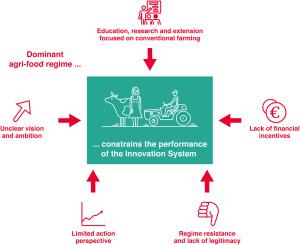Agricultural Systems ( IF 6.1 ) Pub Date : 2021-10-04 , DOI: 10.1016/j.agsy.2021.103280 D.A. Vermunt 1 , N. Wojtynia 1 , M.P. Hekkert 1 , J. Van Dijk 1 , R. Verburg 1 , P.A. Verweij 1 , M. Wassen 1 , H. Runhaar 1

|
CONTEXT
As elsewhere in Western Europe, large scale intensive agriculture dominates the landscape of the Netherlands. Grassland for dairy production occupies more than a quarter of its land surface. The high production intensity on conventionally farmed grassland leads to poor habitat quality, resulting in sharp declines in bird and insect numbers. Nature-inclusive agriculture (NIA) comprises innovations in farm management, technology and resource use that have the potential to address farmland biodiversity decline, but few Dutch farmers implement these.
OBJECTIVE
We aim to analyze the adoption of NIA practices in the Dutch dairy sector. Specifically, we study the influence of the dominant agri-food regime on the innovation system for NIA.
METHODS
Innovation Systems Analysis was performed to identify the various structural barriers which hinder adoption. Our study used a multi-method design in which data on NIA in the Dutch dairy sector was collected via a literature study, four workshops and a focus group discussion.
RESULTS AND CONCLUSIONS
We identified five key blocking mechanisms that hinder adoption of nature-inclusive agriculture in the Dutch dairy sector: (1) insufficient economic incentives for farmers, (2) limited action perspective of many dairy farmers in the Netherlands, (3) lack of a concrete and shared vision for NIA, (4) lack of NIA-specific and integral knowledge and (5) regime resistance, which moreover is connected to each of the previous blocking mechanisms. Our analysis shows that one of the empirical novelties of this paper is that these blocking mechanisms are strongly interlinked in the Dutch dairy sector, thereby perpetuating a situation of lock-in. We conclude that in order to accelerate adoption of nature-inclusive farming practices, problems need to be addressed in conjunction with one another, and therefore holistic approaches are key. A second important conclusion is that in order to foster growth of the innovation system around NIA, the focus should not only be on innovation, but also on transforming current regimes, in particular the currently dominant economic paradigms of growth and yield maximization.
SIGNIFICANCE
By unraveling strongly interlinked blocking mechanisms, this paper provides intervention points to accelerate the transition towards NIA in the Netherlands. These intervention points are not only located within the innovation system, but should preferable be sought for in the broader structures and institutions of the dominant agri-food regime.
中文翻译:

阻碍向“自然包容”农业过渡的五种机制:荷兰奶牛养殖的系统分析
语境
与西欧其他地方一样,大规模集约化农业主导着荷兰的景观。用于乳制品生产的草地占其陆地面积的四分之一以上。传统养殖草地的高生产强度导致栖息地质量差,导致鸟类和昆虫数量急剧下降。自然包容性农业 (NIA) 包括农场管理、技术和资源利用方面的创新,这些创新有可能解决农田生物多样性下降的问题,但很少有荷兰农民实施这些创新。
客观的
我们旨在分析荷兰乳制品行业采用 NIA 实践的情况。具体而言,我们研究了主导农业食品制度对 NIA 创新系统的影响。
方法
进行了创新系统分析,以确定阻碍采用的各种结构性障碍。我们的研究使用了多方法设计,其中荷兰乳制品行业的 NIA 数据是通过文献研究、四个研讨会和焦点小组讨论收集的。
结果和结论
我们确定了阻碍荷兰奶业采用自然包容性农业的五个关键机制:(1) 对农民的经济激励不足,(2) 荷兰许多奶农的行动视角有限,(3) 缺乏具体的和 NIA 的共同愿景,(4) 缺乏 NIA 特定和完整的知识,以及 (5) 政权抵抗,而且这与之前的每个阻止机制有关。我们的分析表明,本文的实证创新之一是这些阻塞机制在荷兰乳制品行业中密切相关,从而使锁定的情况长期存在。我们得出的结论是,为了加速采用包容自然的农业实践,问题需要相互结合解决,因此整体方法是关键。
意义
通过解开强烈相互关联的阻塞机制,本文提供了干预点,以加速荷兰向 NIA 的过渡。这些干预点不仅位于创新系统内,而且应该在占主导地位的农业食品制度的更广泛的结构和机构中寻找。









































 京公网安备 11010802027423号
京公网安备 11010802027423号